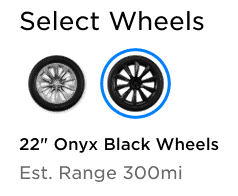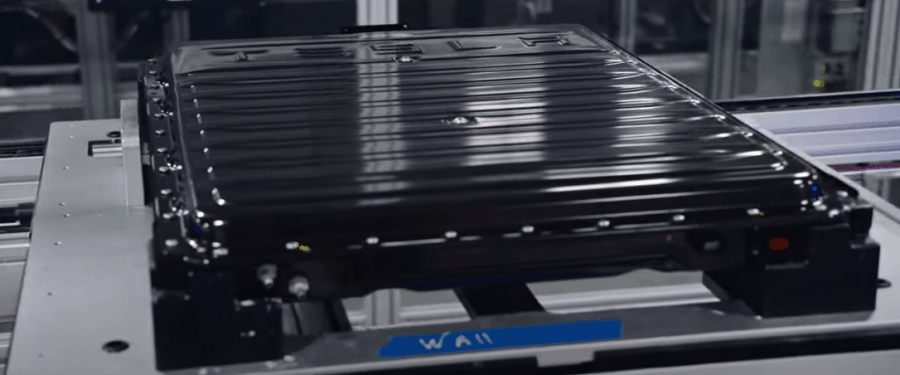Many people are surprised at just how fast Tesla’s are, but perhaps equally as impressive, is the amount of weight the have to move to do so! For anyone new to electric vehicles, you might be shocked at the curb weight of a Tesla (or any other EV). We’ll cover the topic of how much a Tesla weighs, pros and cons of the weight, and variables dependent on the vehicle configuration.
When compared to internal combustion engine vehicles of similar dimensions, a Tesla will certainly weigh more. This weight is mostly in the battery packs. If you’ve ever lifted a traditional 12v car battery, you’ll immediately notice how heavy batteries can be for their size. Compared to equally sized lead acid batteries, lithium ion batteries (which are used in the Tesla battery pack) are only 1/3 of the weight.
A Tesla battery pack is made up of small, cylindrical battery cells that are a part of a module. These battery cells are similar to ones you would find in laptop computers, only a whole lot more of them. The Tesla Model S and X us 18650 cells in 16 modules and the Model 3 and Y use 2170 cells in 4 modules.
How Much Does a Tesla Battery Pack Weight?
The older Tesla 85 kWh battery pack weighed in at 1,200 pounds. With the Model 3 Long Range, the battery pack weighs 1,060 pounds. Now, let’s compare that to gasoline. A gallon of gas was 6.3 pounds. An average car gas tank is around 15 gallons which comes out to 94.5 pounds when full.
Up next, we’ll take a look at the weight of the current Tesla lineup. Over the years, Tesla has offered various sized battery packs. For a short while, they offered a 40kWh battery pack in the Model S. Tesla discontinued it back in 2013. Today, only the 100kWh battery pack is available on the Model S and X. Tesla has offered 60, 70, 75, 85, and 90 kWh packs for the Model S. Today, the 100 kWh pack is standard on both the Model S and Model X. Previous battery packs available on the Model X included 60, 75, 90 since it debuted in 2016. The 60 kWh pack fell way side similar to the 40 kWh pack on the Model S, enough demand wasn’t there.
The Tesla Model 3 Standard Range Plus has a 54 kWh battery pack. On the Model 3 Long Range variant, there’s a 75 kWh battery pack.
Tesla Weight
This is the weight of the current lineup:
| Lowest Weight | Highest Weight | |
| Model S | 4,815 lbs (Long Range Plus) | 4,929 lbs (Performance) |
| Model X | 5,437 lbs (Long Range Plus) | 5,498 lbs (Performance) |
| Model 3 | 3,582 lbs (Standard Plus) | 4,065 lbs (Long Range AWD and Performance) |
| Model Y | 4,416 (Long Range AWD) | 4,416 lbs (Performance |
Depending on the year and model, a Tesla battery pack makes up approximately 30% of the entire vehicle weight. Unless technology drastically changes or there’s demand for much shorter range vehicles, these numbers likely won’t change any time soon.
The Tesla Cybertruck is scheduled to go into production late 2021. It will have 3 variants, a single, dual, and tri-motor version. While Tesla currently hasn’t listed in specs for the vehicle weight, it has been estimated the truck will weigh over 5,000 pounds and could even break 6,000 pounds for the dual and tri-motor versions. However, I could see it weighing more. Depending on the options, an F-150 can weigh 4,500 pounds and tip over 5,000 pounds. Factor in enough battery cells for the Tri-Motor version to get the estimated 500+ miles of range, I can see the Cybertruck really tipping the scales.
We’ll also go through some of the pros and cons of all that weight. Let’s take a look at that now…
Potential Additional Tesla Weight
Wheel and Tire Weight
While Tesla’s website doesn’t indicate an increase in weight for various wheel options, there’s likely an additional weight (usually the larger you go). For the Tesla Model X Performance, selecting the 20″ rim estimates 341 miles of range.

Jumping up to the 22″

Jumping up to the 22″ Onyx rim on the Tesla Model X will drop your estimated range down to 300 miles per charge. That’s a difference of 41 miles between the 20 and 22″ wheel!
On the Model S Performance, the 19″ Tempest rim shows an estimated 387 miles of range. Jump up to the Sonic Carbon Twin Turbine wheels and the range drops to an estimated 334 miles. That’s an even larger difference of 53 miles per charge compared to the Model X.
Tesla currently does not show any range differences for the Model 3 and Y wheel configurations, however, similar to the S and X, some differences in range are likely.
Wheel Weight or Aerodynamics?
While weight could be a factor between wheel sizes and designs, aerodynamics can also play a part. Car and Driver did a test with and without the Model 3 Aero Wheel covers. They found that keeping them on provided a 3.4% range increase at three different speeds. This yields up to 10 miles of range increase.
Reducing Weight for Racing (Tesla Seat Comparison)
Many of those who race at the drag strip or other locations will trim weight from their vehicle any way they can. If that means lighter components such as carbon fiber body panels or removing back seats, trim pieces, and a passenger seat these components are frequently taken out. With the Model X offering 5, 6, or 7 passenger seating, the 6 and 7 passenger versions will add additional weight as well.
Advantages of Heavier Tesla Weight
With what they refer to as a skateboard design, the battery pack is placed within the vehicle chassis. This provides a very low center of gravity which can significantly reduce vehicle roll and improve handling, especially in the corners. Tesla vehicles have very evenly balanced weight distribution as well. The Model S has a weight distribution of 48% front, 52% rear. On the Model X, the weight distribution is 49% up front and 51% out back. For the Model 3, the front makes up 47% and the rear 53%.

Disadvantages of a Heavier Vehicle
Perhaps the most obvious disadvantage is the additional weight that needs to be moved to get going. As we mentioned above, many racers obsess over losing vehicle weight even if it’s only a few pounds here and there. The additional weight can affect all aspects of speed. Top speed and acceleration are impacted. The trade-off for a smaller battery pack and less range probably won’t happen any time soon. One of the reasons Tesla dropped the 40 kWh battery option was it only accounted for about 4% of sales.
Heavier overall vehicle weight with EV’s also seems to cause faster tire wear. We noticed it with our Nissan LEAF coming up far short of the warranty mileage of the second set of tires it received. Here’s a quote from Continental Tire’s website regarding tires on electric vehicles:
“Electric engine torque also has a positive and negative side. On the one hand, it means instant acceleration. On the other hand, this high instant torque places additional strain on the tires.”
Continental Tires
More from Continental Tires regarding tires on electric vehicles:
https://www.continental-tires.com/car/tire-knowledge/tire-basics/electric-vehicle-tires
Summary
Bottom line, Tesla battery packs can add over 1,000 pounds to the vehicle compared to a similarly sized internal combustion engine vehicle with a full tank of gas. As their technology improves, this weight may or may not be reduced. At some point there may no longer be a chase for more range. There are company’s out there who have even talked about battery-less electric vehicles. For the timing being though, expect a bit more range and Tesla vehicles to remain fairly heavy.
More Tesla Posts on Fabville!
Looking for more Tesla articles? Check out more of our Tesla posts.
If you’re looking to purchase a new Tesla vehicle or Tesla Energy product, please consider using my referral code (link to Tesla with my code): https://ts.la/kevin82163

